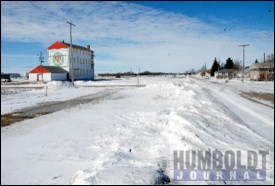Ignored or forgotten for so long, questions are finally starting to creep up as to what should be done with "Elevator Alley."
The land in question comprises all four blocks of land boxed in by 5th Avenue, 6th Avenue, 11th Street, and 17th Street. It is currently zoned for industrial use, but has remained empty and unused since at least 2010.
"We haven't done any tests, but several properties have had environmental tests done," said Anthony Andre, a junior planner for the City of Humboldt. "We're working with the Ministry of Environment for the remaining properties, but it takes a while to get information."
Earlier this year, Darryl Classen submitted a request to construct an apartment building on that property. To assess the feasibility of the project, council initiated a Local Area Plan that included a survey of nearby residents. Although Classen withdrew his initial request, the survey of residents was completed and the responses were intriguing.
Of the 40 respondents, green space seemed to have the greatest number of votes followed by requests to see abandoned buildings such as the old flour mill removed.
"It's nice that it's so close to the Uniplex and the school and it's pretty central, but being so close to the tracks makes for some noise," said Lorelle Holowaty, a resident who lives in that neighbourhood. "A green belt might be optimal for kids to play, but it should probably be fenced."
According to the survey, it seems that almost half of the people that responded want to see a mix of residential and commercial land use. They valued pedestrian connectivity, neighbourhood aesthetics, and environmental consciousness as well.
A couple of residents appreciated the open space, but said they would like some sort of buffer between the tracks and the neighbourhood to stifle the railway sounds. A few of the suggestions seemed to focus on a line of trees.
With regards to what the land should be used for, there was little dissent. Half of the respondents voted for some form of green space. Apparently the school field offers little shade and no picnic tables to sit at. The only concern was danger posed to children playing in the area, but even that can be fixed with a simple fence.
Regardless of what people want, there are still quite a few factors that need to be taken into consideration before anything can be decided. Originally, that property was zoned for industrial use because it was on the outskirts of town. As Humboldt grew into a city, that was no longer the case. Now, until a developer decides to undertake a project there, the land will remain unused.
"All of the lots are private except for the one at the very end between 15th and 17th street, which belongs to the city," said Andre. "If you were to build houses, the site would need to be cleaned first. There could be fuel leaks from tanks that were there."
Despite the city's local area plan, it could realistically be twenty years before anything is done with the area, said Andre. The plan is just to determine what the land would be most suitable for.
"It's good because it has potential. If it's changed to residential, it would be good because the school is so close," said Dan Torwalt from Century 21 Diamond Realty. "It has proximity to everything and has 5th Avenue as a buffer zone."
Torwalt also agrees that putting up a line of trees or a berm of dirt would act as a decent buffer against the sound of the trains. Mostly though, he said it's just getting over the mindset of being so close.
"It's not like they'd be putting housing between the highway and the tracks," he said. "We already have people looking at houses on the east side of Main Street. It's not that big of a deal."
It's not unusual to have tracks going through small towns. The biggest issue, said Torwalt, is safety. However, with schools so close, it's already proven to be not that big of an issue.
"Safety is a thing, it's always a concern. It should be addressed, but you do have 5th Avenue as a buffer," said Torwalt.
"Respect the people in the community. When they bring those concerns to the city, make a judgement call, evaluate it, and do the studies."
Nevertheless, developers build stuff to make money. It costs a lot to build, so any potential structural project would have to have the means of returning the cost of the project. A multiuse centre, as some people suggested, may not be feasible on the land if people aren't willing to pay for it. Developers have to get a return on their investment, said Torwalt.
"The results of the local area plan might not be what people are looking for, but it plays a role in what's determined," said Andre. "Right now the city is leaning toward a commercial and residential mix, but the plan is still incomplete. There might be changes once we get all the information."




